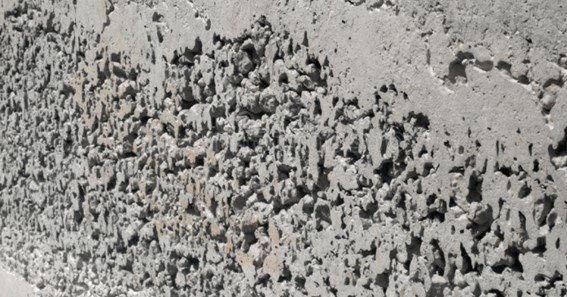Are you curious to know what is honeycombing? You have come to the right place as I am going to tell you everything about honeycombing in a very simple explanation. Without further discussion let’s begin to know what is honeycombing?
In the realm of construction, engineers and professionals encounter various challenges and anomalies that require careful analysis and attention. One such phenomenon is honeycombing. In this blog, we will explore the concept of honeycombing in construction, its causes, implications, and measures to prevent and address this structural anomaly.
What Is Honeycombing?
Honeycombing, also known as voids or cavities, refers to a condition in concrete where the mixture fails to completely fill the formwork or mold, leaving empty spaces or pockets within the structure. These irregular voids resemble the appearance of a honeycomb, hence the term “honeycombing.”
Causes Of Honeycombing:
- Inadequate Vibrations: Insufficient vibration during concrete placement is a common cause of honeycombing. Vibrations help the concrete mixture settle and eliminate air pockets. If proper vibration techniques are not employed, air voids can form, resulting in honeycombing.
- Improper Concrete Consistency: The consistency of the concrete mixture plays a vital role in preventing honeycombing. If the mixture is too dry or stiff, it becomes difficult to achieve proper compaction, leading to voids within the structure.
- Inadequate Formwork Design: Poor formwork design or improper installation can contribute to honeycombing. If the formwork does not adequately contain the concrete mixture or if it allows excessive leakage, the resulting gaps can lead to honeycombing.
- Concrete Pouring Techniques: Improper pouring techniques, such as excessive drop heights or inadequate flow control, can cause segregation of the concrete mixture. This segregation leads to the accumulation of aggregates and water in certain areas, resulting in honeycombing.
Implications And Risks:
Honeycombing in concrete structures can have several implications and risks:
- Reduced Structural Integrity: The presence of voids compromises the structural integrity of the concrete. Honeycombing weakens the overall strength and durability of the structure, increasing the risk of cracks, water infiltration, and potential structural failure over time.
- Aesthetics and Surface Durability: Honeycombing can affect the appearance and surface quality of the concrete. The irregular voids may be visible on the finished surface, impacting the aesthetics and potentially reducing the durability of the concrete.
- Increased Permeability: Honeycombing creates pathways for moisture and contaminants to penetrate the concrete. This increases the risk of corrosion in reinforced steel, leading to potential structural deterioration and compromised longevity.
Prevention And Remediation:
- Proper Concrete Mix Design: Ensuring the concrete mixture has the correct water-cement ratio and appropriate consistency is essential to prevent honeycombing. Proper mix design reduces the likelihood of segregation and promotes better compaction during pouring.
- Adequate Formwork and Reinforcement: Using high-quality formwork that securely contains the concrete mixture helps prevent leakage and the formation of voids. Reinforcing steel bars should be properly placed and secured to ensure optimal concrete placement and compaction.
- Effective Vibration Techniques: Employing appropriate vibration techniques during concrete placement helps to eliminate air voids and achieve proper compaction. Vibrators should be used strategically to ensure complete filling of the formwork and minimize the risk of honeycombing.
- Inspection and Quality Control: Regular inspection during the concrete pouring process allows for the identification of potential honeycombing issues. Quality control measures, such as slump tests, can ensure the concrete mixture meets the desired consistency and workability requirements.
Conclusion:
Honeycombing is a structural anomaly that poses risks to the integrity and longevity of concrete structures. Understanding the causes and implications of honeycombing is crucial in preventing and addressing this phenomenon. By implementing proper mix design, formwork installation, vibration techniques, and quality control measures, construction professionals can minimize the occurrence of honeycombing and ensure the durability and safety of concrete structures. Adhering to best practices and maintaining vigilance throughout the construction process will help mitigate the risks associated with honeycombing and uphold the highest standards of structural integrity.
Visit Longests to know about longest things in the world.
FAQ
What Does Honeycombing In The Lungs Mean?
Honeycombing represents destroyed and fibrotic lung tissue containing numerous cystic airspaces with thick fibrous walls, representing the late stage of various lung diseases, with complete loss of acinar architecture.
What Does Honeycombing On Ct Indicate?
Honeycombing on CT is the clue for the diagnosis of usual interstitial pneumonia (UIP) and its hallmark. According to the ATS-ERS-JRS-ALAT 2010 guideline, the patients with honeycombing on CT can be diagnosed as UIP without surgical biopsy.
What Is The Cause Of Honeycombing?
Honeycombing is the term used to describe areas of the surface that are coarse and stony. It may be caused by insufficient fine material in the mix, perhaps due to incorrect aggregate grading or poor mixing.
What Is Honeycombing In Concrete?
Have you ever noticed rough textures, cavities, voids or gaps on the surface of finished concrete? These occurrences are caused majorly due to air voids because the concrete could not fill up the space entirely. It resembles a honey bee nest and therefore gets the term ‘honeycomb in concrete.
I Have Covered All The Following Queries And Topics In The Above Article
What Is Honeycombing In Lungs
What Is Honeycombing In The Lungs
What Is Honeycombing In Concrete
What Is Concrete Honeycombing
What Is Honeycombing On Ecg For Ipf
What Is Honeycombing In Logistics?
What Is The Honeycombing Process For Carving
What Is Honeycombing
What is mean by honeycombing
What is honeycombing in concrete?
